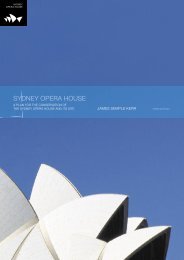July 2 â 3 - Sydney Opera House
July 2 â 3 - Sydney Opera House
July 2 â 3 - Sydney Opera House
Create successful ePaper yourself
Turn your PDF publications into a flip-book with our unique Google optimized e-Paper software.
To plan a storyboard you need to think about the following:<br />
• What do you need to show? (What can the audience assume without needing to see?)<br />
• What shots do you want to use? Where is a long shot/close-up etc required?<br />
• What camera angles are appropriate?<br />
• Where will the actors be? Which direction do they come on and off or move around in the shot?<br />
• Where will the camera be placed?<br />
• What sort of light do you want?<br />
A O'Brien ACM I 2003<br />
Camera Shots, angles and movement<br />
Filmmakers use a variety of shots to tell their story visually. Below are the most common shot types and<br />
camera movement descriptions used in storyboards.<br />
Common shot types include the following:<br />
• WIDE SHOTS – show the whole person or the whole feature object as part of the landscape. This is<br />
often the opening shot since it establishes the location and often the time and mood of the action<br />
• MID SHOTS – show the actors from the waist up<br />
• CLOSE-UPS – show the actor's face or a significant object and allow the audience to judge the<br />
characters’ reaction to the action<br />
• EXTREME CLOSE-UP shots – used for dramatic emphasis<br />
• A POINT OF VIEW (POV) shot – the camera shares a character's point of view, and appears to be<br />
looking through their eyes.<br />
Message Sticks Teacher Kit 2008 ©ACMI 9

















